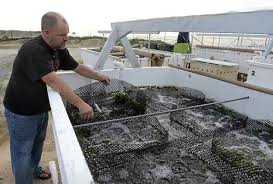Principal Investigators: Jan English-Lueck, A.J. Faas, Charlotte Sunseri
Project Members:
Graduate Students: Gianina Bebb, Leah Grant, Angela Moniz, Veronica Saldivar
Undergraduate Students: Kris Cameron, Jillian Ferini, Aaron van Valen
Alumna: Auda Velazquez-Rivera
SJSU Staff: Teri Graziani (IRC)
Project Partners: New Museum of Los Gatos (NUMU), Indian Health Center of Santa Clara Valley

Exhibit opening event participants Teri Graziani, Leah Grant, Jan English-Lueck, Jeff Gregor, and Alisha Ragland.
On November 4, 2016 an exhibit opened at the NUMU (New Museum of Los Gatos) entitled Cement Prairie: The History and Legacy of the 1952 American Indian Urban Relocation Program which was the result of collaboration among a team of SJSU anthropologists, the NUMU curator Amy Long, and leadership at the Indian Health Center of Santa Clara Valley. Stories of the experiences of American Indians relocated to San Jose from distant home reservations were told through filmed oral narratives and historical archival materials gathered from the Bancroft Library at UC Berkeley, the National Archives at San Bruno, and many private photo collections.
The Urban Relocation Project (or Indian Relocation Act of 1956) was a federal program of voluntary relocation of young adults from reservations to urban centers. The program was advertised as a means of accessing work opportunities away from the reservation yet driven by goals of assimilation. Despite the prior attempts at Indian assimilation through boarding schools, many joined the program to assert control over their futures and opportunities. The program resulted in several unintended consequences, from cultural fluorescence and pan-Indian identity to regional and then national collective action and organizing for social change. The program heightened awareness concerning the struggles for self-determination experienced by tribes who were not recognized by the federal government, as was solidarity for civil rights concerns of American Indians more broadly. Relocatees to San Jose were moved from reservations of sovereign tribes into the traditional homeland of the Muwekma Ohlone, which at times led to tensions. A sister exhibit Back from Extinction: Muwekma Ohlone’s Heritage, History, and Legacy at NUMU tells the story of the Bay Area tribe whose federal recognition was previously terminated, and who live on to be vital contributors to the American Indian community of the Bay Area.
The Cement Prairie exhibit featured a 20-minute film of oral histories and relocation narratives gathered by SJSU anthropologists. Teri Graziani and the Instructional Resource Center at SJSU finalized the video cuts and produced the film for educational use, the museum exhibit, and a YouTube channel on this topic. The narratives in this film highlight the issues of American Indian experiences in maintaining culture and making community, their sense of home and process of moving to San Jose, and conflicts or issues faced and overcome in this process. The stories of those relocated from reservations to urban areas reveal the lasting legacies of this program for strengthening pan-Indian identity, establishing community-building events such as Bay Area powwows, and organizing for social justice (e.g. American Indian Alliance, American Indian Movement, etc.). Beyond the exhibit, the results of this study will include an archive of relocatees’ oral histories, further inquiry to understand the experiences of those who returned to their home reservations after joining the Relocation Program, and continued partnership with initiatives of the Indian Health Center of Santa Clara Valley.
Both exhibits are open for visitors through June 2017, and a special event on January 12 will feature a panel discussion with a number of the San Jose relocatee community.
http://www.numulosgatos.org/exhibitions-2/2016/11/4/cement-prairie-the-history-and-legacy-of-the-american-indian-urban-relocation-program-of-1956
The SJSU-produced film “Voices of American Indian Urban Relocation in San Jose, CA” can be viewed online:
https://www.youtube.com/watch?v=b9CYF4c41No
The Cement Prairie exhibit was featured in the San Jose Metro, and the review is available:
http://www.metroactive.com/arts/Cement-Prairie-Pan-Indianism-American-Indian-Movement-NUMU-Los-Gatos-Exhibit.html


NUMU corridors of the “Cement Prairie” (top) and “Back from Extinction” (bottom) exhibits.




